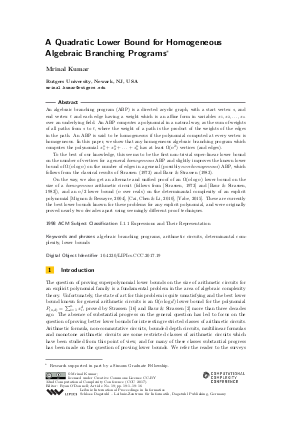A Quadratic Lower Bound for Homogeneous Algebraic Branching Programs
Author Mrinal Kumar
-
Part of:
Volume:
32nd Computational Complexity Conference (CCC 2017)
Part of: Series: Leibniz International Proceedings in Informatics (LIPIcs)
Part of: Conference: Computational Complexity Conference (CCC) - License:
 Creative Commons Attribution 3.0 Unported license
Creative Commons Attribution 3.0 Unported license
- Publication Date: 2017-08-01
File

PDF
LIPIcs.CCC.2017.19.pdf
- Filesize: 0.49 MB
- 16 pages
Document Identifiers
Subject Classification
Keywords
- algebraic branching programs
- arithmetic circuits
- determinantal complexity
- lower bounds
Metrics
- Access Statistics
-
Total Accesses (updated on a weekly basis)
0Document
0Metadata
Abstract
An algebraic branching program (ABP) is a directed acyclic graph, with a start vertex s, and end vertex t and each edge having a weight which is an affine form in variables x_1, x_2, ..., x_n over an underlying field. An ABP computes a polynomial in a natural way, as the sum of weights of all paths from s to t, where the weight of a path is the product of the weights of the edges in the path. An ABP is said to be homogeneous if the polynomial computed at every vertex is homogeneous. In this paper, we show that any homogeneous algebraic branching program which computes the polynomial x_1^n + x_2^n + ... + x_n^n has at least Omega(n^2) vertices (and edges). To the best of our knowledge, this seems to be the first non-trivial super-linear lower bound on the number of vertices for a general homogeneous ABP and slightly improves the known lower bound of Omega(n log n) on the number of edges in a general (possibly non-homogeneous) ABP, which follows from the classical results of Strassen (1973) and Baur--Strassen (1983). On the way, we also get an alternate and unified proof of an Omega(n log n) lower bound on the size of a homogeneous arithmetic circuit (follows from [Strassen, 1973] and [Baur-Strassen, 1983]), and an n/2 lower bound (n over reals) on the determinantal complexity of an explicit polynomial [Mignon-Ressayre, 2004], [Cai, Chen, Li, 2010], [Yabe, 2015]. These are currently the best lower bounds known for these problems for any explicit polynomial, and were originally proved nearly two decades apart using seemingly different proof techniques.
Cite As Get BibTex
Mrinal Kumar. A Quadratic Lower Bound for Homogeneous Algebraic Branching Programs. In 32nd Computational Complexity Conference (CCC 2017). Leibniz International Proceedings in Informatics (LIPIcs), Volume 79, pp. 19:1-19:16, Schloss Dagstuhl – Leibniz-Zentrum für Informatik (2017)
https://doi.org/10.4230/LIPIcs.CCC.2017.19
BibTex
@InProceedings{kumar:LIPIcs.CCC.2017.19,
author = {Kumar, Mrinal},
title = {{A Quadratic Lower Bound for Homogeneous Algebraic Branching Programs}},
booktitle = {32nd Computational Complexity Conference (CCC 2017)},
pages = {19:1--19:16},
series = {Leibniz International Proceedings in Informatics (LIPIcs)},
ISBN = {978-3-95977-040-8},
ISSN = {1868-8969},
year = {2017},
volume = {79},
editor = {O'Donnell, Ryan},
publisher = {Schloss Dagstuhl -- Leibniz-Zentrum f{\"u}r Informatik},
address = {Dagstuhl, Germany},
URL = {https://drops.dagstuhl.de/entities/document/10.4230/LIPIcs.CCC.2017.19},
URN = {urn:nbn:de:0030-drops-75134},
doi = {10.4230/LIPIcs.CCC.2017.19},
annote = {Keywords: algebraic branching programs, arithmetic circuits, determinantal complexity, lower bounds}
}
Author Details
References
- Matthew Anderson, Michael A. Forbes, Ramprasad Saptharishi, Amir Shpilka, and Ben Lee Volk. Identity testing and lower bounds for read-k oblivious algebraic branching programs. In Proceedings of the \ifnumcomp2016<1996\nth\intcalcSub20161985 Annual Structure in Complexity Theory Conference (Structures 2016)\ifnumcomp2016<2015\nth\intcalcSub20161985 Annual IEEE Conference on Computational Complexity (CCC 2016)\nth\intcalcSub20161985 Annual Computational Complexity Conference (CCC 2016), volume 50 of LIPIcs, pages 30:1-30:25, 2016. URL: http://dx.doi.org/10.4230/LIPIcs.CCC.2016.30.
- Walter Baur and Volker Strassen. The complexity of partial derivatives. Theoretical Computer Science, 22:317-330, 1983. URL: http://dx.doi.org/10.1016/0304-3975(83)90110-X.
- Eli Ben-Sasson and Swastik Kopparty. Affine dispersers from subspace polynomials. SIAM J. Comput., 41(4):880-914, 2012. URL: http://dx.doi.org/10.1137/110826254.
- Jin-yi Cai, Xi Chen, and Dong Li. Quadratic lower bound for permanent vs. determinant in any characteristic. Computational Complexity, 19(1):37-56, 2010. URL: http://dx.doi.org/10.1007/s00037-009-0284-2.
- David A. Cox, John B. Little, and Donal O'Shea. Ideals, Varieties and Algorithms. Undergraduate texts in mathematics. Springer, 2007. URL: http://dx.doi.org/10.1007/978-0-387-35651-8.
-
Michael A. Forbes. Polynomial Identity Testing of Read-Once Oblivious Algebraic Branching Programs. PhD thesis, Massachusetts Institute of Technology, 2014.

- Kyriakos Kalorkoti. A Lower Bound for the Formula Size of Rational Functions. SIAM Journal of Computing, 14(3):678-687, 1985. URL: http://dx.doi.org/10.1137/0214050.
- Thierry Mignon and Nicolas Ressayre. A quadratic bound for the determinant and permanent problem. International Mathematics Research Notes, 2004(79):4241-4253, 2004. URL: http://dx.doi.org/10.1155/S1073792804142566.
-
E. I. Nechiporuk. On a boolean function. Soviet Math. Dokl., pages 999-1000, 1966.

- Noam Nisan. Lower bounds for non-commutative computation. In Proceedings of the \nth\intcalcSub19911968 Annual ACM Symposium on Theory of Computing (STOC 1991), pages 410-418, 1991. URL: http://dx.doi.org/10.1.1.17.5067.
- Ramprasad Saptharishi. A survey of lower bounds in arithmetic circuit complexity. Github survey, 2015. URL: https://github.com/dasarpmar/lowerbounds-survey/releases/.
-
Ramprasad Saptharishi. personal communication, 2016.

- Amir Shpilka and Amir Yehudayoff. Arithmetic circuits: A survey of recent results and open questions. Foundations and Trends in Theoretical Computer Science, 5:207-388, March 2010. URL: http://dx.doi.org/10.1561/0400000039.
-
J. Smith. Introduction to Algebraic Geometry. Textbooks in Mathematics. Taylor &Francis, 2014.

- Roman Smolensky. Easy lower bound for a strange computational model. Computational Complexity, 6(3):213-216, 1997. URL: http://dx.doi.org/10.1007/BF01294255.
-
V. Strassen. Die Berechnungskomplexiät von elementarsymmetrischen Funktionen und von Interpolationskoeffzienten. Numerische Mathematik, 20:238-251, 1973.

- Akihiro Yabe. Bi-polynomial rank and determinantal complexity. CoRR, abs/1504.00151, 2015. URL: http://arxiv.org/abs/1504.00151.
